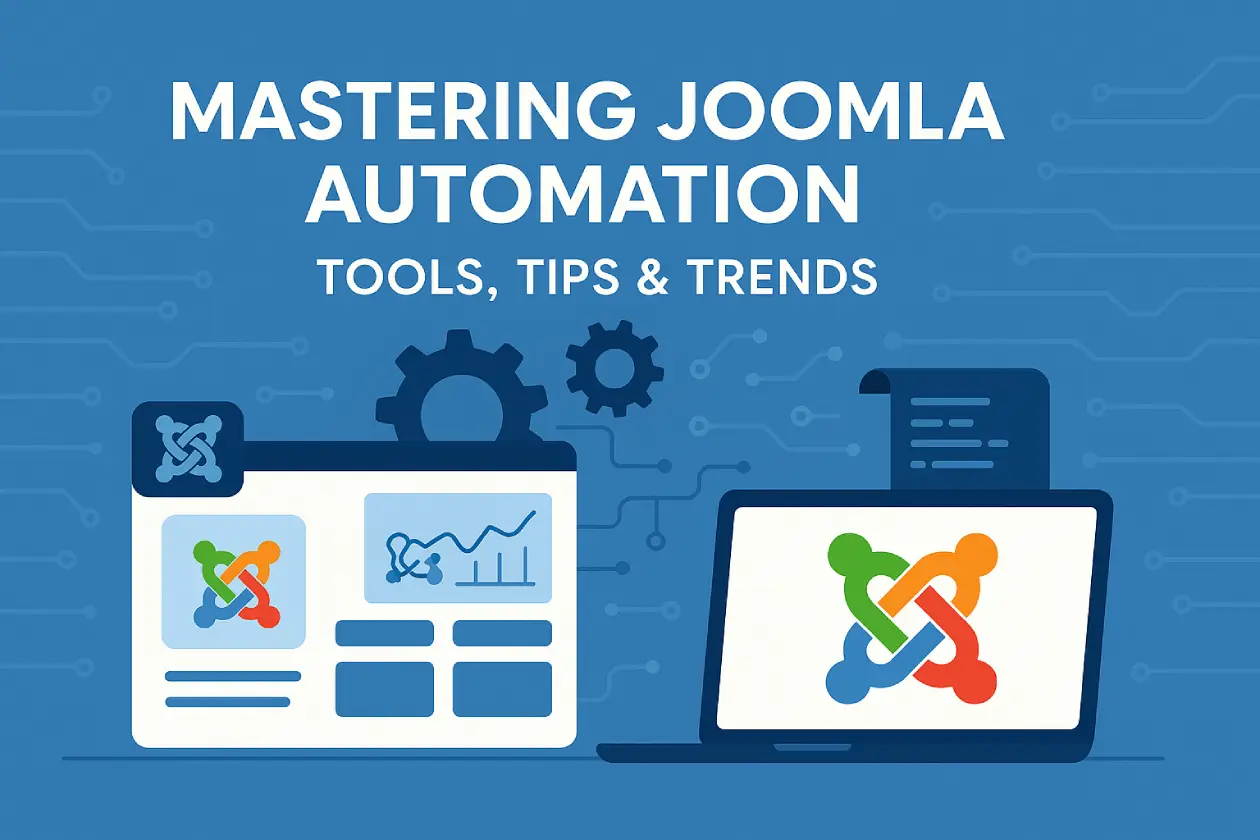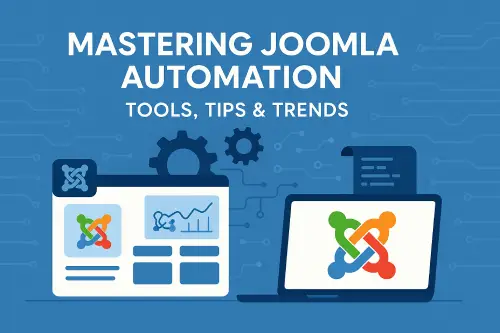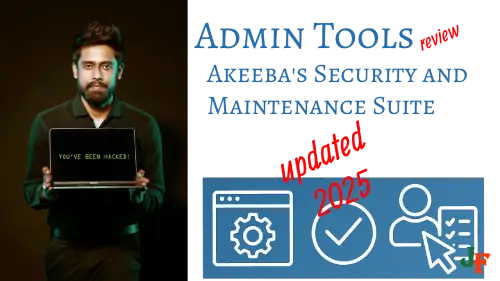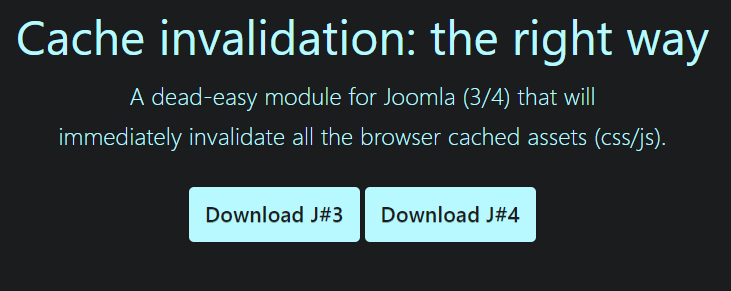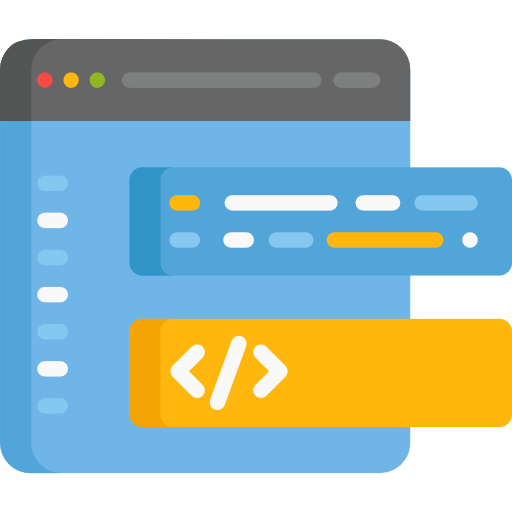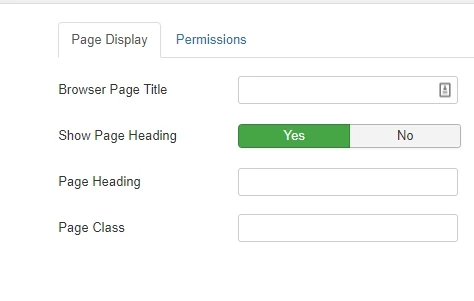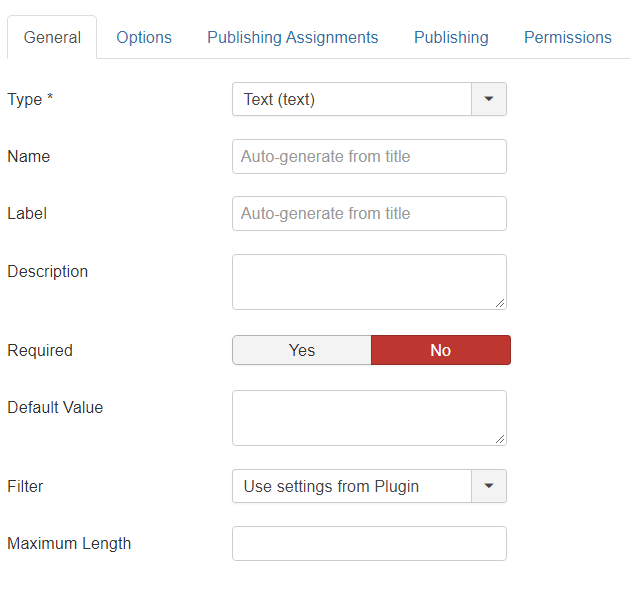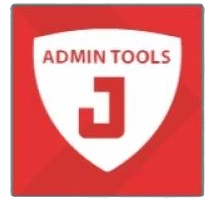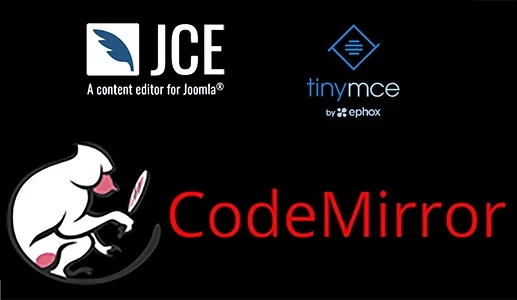Automation tools streamline repetitive tasks, allowing users to save time and reduce manual errors. Popular no-code automation platforms include Zapier, Make.com (formerly Integromat), and IFTTT.
Introduction to Joomla Automation
Overview of Automation Tools
- Zapier is focused on business productivity. It connects over 3,000 apps and is ideal for automating workflows like form submissions, data syncing, or content sharing. Its user-friendly interface and robust support make it suitable for businesses looking to automate common tasks.
- Make.com offers greater flexibility and customization. It supports conditional logic, advanced scenarios, and API integrations, making it a good fit for users needing more control over how automations behave. Compared to Zapier, it may have a steeper learning curve but offers more power for complex tasks.
- IFTTT (If This Then That) is beginner-friendly and geared toward simpler, consumer-level automations. It's commonly used for social media sharing, device control, and lightweight task automation.
Each platform has its strengths: Zapier excels in ease of use and app coverage, Make.com stands out for flexibility and advanced routing, and IFTTT is perfect for lightweight, low-complexity tasks.
The Role of Joomla in CMS Ecosystem
Joomla is an open-source content management system (CMS) used for building websites and online applications. Known for its flexibility and extensibility, it's one of the leading CMS platforms alongside WordPress and Drupal. Joomla supports a broad range of website types, from corporate portals to community-based sites.
Automation plays a crucial role in managing Joomla sites efficiently. Tasks such as publishing content, managing user accounts, processing form submissions, and syncing data with external platforms can be automated to reduce administrative overhead. Using the right automation tools, Joomla administrators and developers can streamline operations and maintain a more consistent, error-free site experience.
Exploring Make.com for Joomla Automation
Introduction to Make.com
Make.com (formerly known as Integromat) is a powerful integration and automation platform known for its visual workflow builder and comprehensive feature set. With its intuitive drag-and-drop interface, users can create complex automations—called "scenarios"—without needing to write code. It supports a wide range of apps, including Joomla, enabling users to automate tasks such as content updates, user registration handling, and data transfers.
Compared to other automation tools such as Zapier and IFTTT, Make.com stands out for its flexibility and depth. While Zapier and IFTTT offer user-friendly experiences with simpler workflows, Make.com allows for more advanced logic, conditional operations, and multi-step processing. For Joomla users requiring detailed workflows and data transformations, Make.com provides greater customizability and control.
Benefits of Using Make.com with Joomla
Using Make.com with Joomla can significantly enhance efficiency and reduce the workload associated with repetitive tasks. Automating content syndication, user management, or database updates can save substantial time for developers and administrators. Make.com also enables faster integration with external platforms like Google Sheets, CRMs, and email providers without needing custom development.
By reducing manual input and the associated risks of human error, Make.com helps streamline operations. For instance, a scenario could automatically create a backup of Joomla articles to a cloud storage solution each time new content is published, ensuring data safety and consistency across platforms. Overall, Make.com delivers robust automation capabilities that not only boost productivity but also improve the reliability of Joomla sites.
Steps to Set Up Joomla Automation with Make.com
Prerequisites for Automation
Before setting up automation between Joomla and Make.com, you need to understand a few core components:
- Understanding APIs and Joomla's API capabilities: Joomla provides a REST API that allows third-party systems to interact with site content, users, and extensions. Familiarity with API endpoints, authentication (commonly token-based), and JSON data formats is essential.
- Necessary plugins and extensions for Joomla: Depending on your automation goals, you may need to install API-enabling extensions or plugins that provide more granular access to Joomla’s data. Ensure your Joomla site runs on a version that supports API connectivity (Joomla 4.x and above), and check for any security settings that might block external integrations.
Step-by-Step Setup Guide
- Creating an account on Make.com
- Visit Make.com and register for a free account.
- Once registered, log in to access the dashboard where you can create and manage automation workflows (called scenarios).
- Connecting Joomla to Make.com via API
- In your Joomla admin panel, go to Users > Web Services to create a new API token or user.
- In Make.com, create a new connection using the HTTP or Webhooks module. Enter the base URL of your Joomla site’s API (e.g.,
https://yourdomain.com/api/index.php) and supply the authentication token in the request headers. - Test the connection to ensure Make.com can communicate with your Joomla site.
- Building your first automation scenario
- In Make.com, click "Create a new scenario."
- Choose the starting module (e.g., an HTTP trigger that listens for new content posted to your Joomla site).
- Add one or more action modules to process or route the data—for example, sending an email notification, posting to Slack, or inserting data into a Google Sheet.
- Testing and troubleshooting common issues
- Always run a scenario in test mode before enabling it live. Use Joomla's and Make.com's error logs for debugging.
- Common issues include failed authentication, improper endpoint configuration, or malformed data. Double-check API headers, payload formats, and permissions on the Joomla side.
- If the scenario fails, hover over the error icon in Make.com for detailed debugging information.
By following these steps, you can automate repetitive Joomla tasks efficiently using Make.com’s no-code interface.
Advanced Automation Techniques
Integrating with Other Tools
Joomla can be integrated with a wide range of third-party tools to enhance your site's automation capabilities. Extensions like J2Store, AcyMailing, and Jootool let you connect Joomla with tools such as CRMs, email marketing platforms, and social media schedulers.
For example, you can automate email campaigns by linking Joomla with Mailchimp through AcyMailing. When a user registers or completes a purchase on your site, they can be automatically added to a segmented email list. Similarly, integrations with tools like Zapier or n8n allow Joomla to trigger events in other applications. A new article published on your Joomla site could automatically be shared on social media platforms or trigger a Slack notification.
These integrations can improve efficiency and ensure that marketing, sales, and content workflows stay synchronized.
Customizing Automation Workflows
Joomla’s automation extensions often allow the use of filters and conditions to refine automated actions. For instance, when using an automation tool to trigger newsletter emails, you can add conditions such as user role, registration date, or custom field values to ensure the correct audience receives tailored content.
Advanced configurations also support multi-step workflows. For example, an e-commerce site might automate the following scenario: when a high-value order is placed, the system sends a thank-you email, adds the customer to a loyalty program, and creates a task in a project management tool for follow-up.
By incorporating conditional logic, time delays, and branching paths, these workflows handle complex scenarios efficiently. Automation tools in Joomla, like Regular Labs' Conditional Content and various workflow management extensions, make these configurations manageable without requiring custom code.
Expert Insights
Interview with an Automation Specialist
To gain a deeper understanding of Joomla automation, we spoke with Marina Lopez, a web developer and automation consultant with over 10 years of experience working with Joomla-based sites. Her takeaway was clear: "Automation in Joomla isn't about replacing human input—it's about streamlining repetitive tasks so teams can focus on growth and user engagement."
Key insights and tips:
- Start simple. Lopez recommends automating basic workflows first, such as content publication and user registration emails, before moving to more complex sequences.
- Use trusted extensions. "Joomla has a robust extension ecosystem—tools like Regular Labs and Akeeba Backup can significantly ease routine maintenance and content workflows," she said.
- Test thoroughly. "Every automation should be tested on a staging environment to avoid accidental data loss or user confusion."
Real-world usage:
Lopez shared a case where an NGO used automation to streamline content publishing. "They had a team of volunteers submitting content across different time zones. We set up rules so that once an article was submitted and approved, it was automatically scheduled based on the editorial calendar. This reduced lag time and editing errors."
Potential Challenges and Solutions
While Joomla automation offers clear benefits, there are common pitfalls.
Compatibility issues: Extensions or templates may not support automated actions. According to Lopez, "Always check the developer documentation to ensure compatibility with automation tools."Over-automation: Creating too many automations can introduce complexity. Lopez's recommendation: "Document your automations and keep them manageable. Too much automation can lead to debugging nightmares."Security risks: Misconfigured automations can expose sensitive data or grant unintended permissions. To mitigate this, she suggests setting up proper user roles and testing access levels regularly.
In the end, Lopez advised, "The key is balancing automation with control. Good automation complements your workflow—it doesn’t complicate it."
Future of Joomla Automation
Emerging Trends
Joomla automation is evolving rapidly, driven by advancements in technology. One of the most significant trends is the integration of artificial intelligence (AI) and machine learning (ML) into automation processes. These technologies are beginning to power smarter workflows, such as predictive content recommendations and automated maintenance tasks, reducing manual intervention and increasing efficiency.
Another key trend is the expansion of integration capabilities. Joomla is increasingly supporting more third-party services and APIs, allowing users to automate tasks across multiple platforms. This trend enables seamless data flow between Joomla and tools like CRMs, email marketing systems, and analytics platforms, streamlining complex web operations.
Community Contributions
The Joomla community plays a vital role in the future of automation within the platform. Developers and users collaboratively contribute to plugins, extensions, and templates that support automation features. This open-source model encourages the sharing of best practices, reusable code, and documentation—fostering innovation and rapid adoption of new tools.
Community-driven forums, GitHub repositories, and dedicated Joomla working groups provide spaces where ideas are exchanged, challenges are resolved, and new automation functionalities are proposed and implemented. These collaborative efforts ensure that automation in Joomla remains adaptable, sustainable, and attuned to user needs.
Conclusion
Automation has the power to fundamentally enhance how Joomla websites are built, managed, and scaled. From streamlining routine tasks to enabling more strategic development workflows, Joomla automation offers users the opportunity to work smarter and more efficiently.
As the Joomla ecosystem continues to evolve, embracing automation can help users stay ahead of the curve. Whether you're automating content workflows, managing user roles, or integrating third-party tools, there's always room to innovate.
Users are encouraged to explore different Joomla automation tools and techniques, test new workflows, and contribute their experiences to the Joomla community. By sharing what works—and what doesn’t—everyone can grow together and unlock the full potential of Joomla automation.
Citations
- Make.com Overview — Make.com is a powerful visual automation platform that integrates with Joomla and enables users to build custom automated workflows without code.
- Joomla API Documentation — The official Joomla API documentation provides detailed information on available endpoints and integration methods necessary for automation.
- Automation Tools Comparison — A comprehensive comparison of automation platforms that highlights strengths and use cases for tools like Zapier, Make, and others in relation to platforms such as Joomla.
- Community Contributions to Joomla — The Joomla community actively contributes tools, plugins, and extensions that support automation initiatives within the CMS.
Introduction to Joomla Automation
Joomla is an open-source content management system (CMS) used to build websites and online applications. Known for its flexibility and extensibility, Joomla supports a wide range of features including multilingual support, user management, and a robust templating system. It's suitable for everything from personal blogs to complex enterprise websites.
As the demands on web content management grow, automation has become increasingly important. Automation in CMS platforms can reduce repetitive tasks, streamline workflows, and increase efficiency for developers and content managers alike. Automating processes such as content publishing, user management, and security updates helps ensure consistent site performance and reduces the risk of human error.
In this context, Joomla plays a significant role in modern web development. Its extensible architecture and wide ecosystem of extensions make it well-suited for integrating automated solutions that enhance both backend operations and user-facing functionality. Joomla's role in modern web development highlights how the platform continues to adapt to evolving technological needs while supporting powerful automation capabilities.
Integrating Joomla with Other Platforms
Integrating Joomla with other platforms enhances functionality and automates workflows across systems. Joomla’s open-source structure and extensive API support make it adaptable to various third-party tools and platforms.
CRM and Marketing Platforms
CRM tools like Salesforce and HubSpot can be integrated with Joomla to synchronize user data and streamline customer communication. These integrations enable automated lead capturing, user segmentation, and behavior tracking.
eCommerce Platforms
Joomla can connect with eCommerce solutions such as Shopify, Magento, and VirtueMart. These integrations allow for shared inventories, unified customer data, and centralized reporting. Automated sync ensures product data consistency and simplifies order management across platforms.
Social Media and Content Tools
Integrations with tools like Buffer, Hootsuite, or social share plugins allow Joomla sites to automate content distribution. Scheduled publishing and multi-channel dissemination become seamless, saving time on manual posting.
Analytics and Reporting
Joomla supports integration with analytics platforms including Google Analytics and Matomo. These tools provide insights into user behavior, content engagement, and traffic sources. Configuration can be automated via plugins or tag management systems.
Authentication and SSO
Joomla can integrate with identity providers like LDAP, OAuth, or SAML-based solutions to enable Single Sign-On (SSO). This is useful in enterprise environments where centralized user authentication is critical.
APIs and Middleware
For more complex needs, Joomla can interact with other systems using RESTful APIs or middleware platforms such as Zapier and Integromat (Make). These allow for custom automation workflows, such as syncing form submissions to cloud storage or databases.
Integrating Joomla with third-party platforms creates scalable automation possibilities that reduce manual tasks and increase operational efficiency.
JoomFuse: A Case Study
Introduction to JoomFuse
JoomFuse is a powerful integration tool designed for Joomla websites that connects directly with Keap (formerly Infusionsoft), enabling seamless management of memberships, content access, and automated marketing workflows. Its primary purpose is to bridge Joomla’s content management capabilities with Keap’s customer relationship and marketing automation system.
By combining the strengths of Joomla and Keap, JoomFuse allows businesses to automate user management, offer secure member content access, and streamline communication workflows. The integration reduces manual administrative tasks, improving accuracy and saving time across operational efforts.
How JoomFuse Works
The integration process starts by connecting JoomFuse to both Joomla and Keap via a simple installation and configuration routine. Once integrated, users can map Keap tags to Joomla content access, enabling automated control over what registered users can see based on their CRM segmentation.
JoomFuse also includes the JF Portal, a member dashboard that consolidates account information, order history, subscriptions, and access permissions. This keeps members informed while reducing repetitive support requests.
Automation is a core capability. For example, when a contact in Keap is tagged as a customer or subscriber, JoomFuse can automatically create or update a Joomla user account, assign the correct user group, and grant or restrict access accordingly. The reverse is also true—changes in Joomla activity can feed back into Keap for further automation.
Key Features of JoomFuse
- Timely Member Access: JoomFuse grants or revokes access to Joomla content in real time based on Keap tags, ensuring up-to-date user permissions.
- Scalable Automation: The platform supports large-scale automation, making it ideal for growing membership sites, online courses, and content subscriptions.
- Content Security: Precise control over who sees what protects premium content and ensures compliance with access policies.
- Tag-Driven Mapping: Admins can map Keap tags directly to Joomla user groups and content levels, providing granular control of user journeys.
- Automated Accounts: New contacts in Keap can be assigned Joomla user accounts automatically, reducing onboarding friction and user error.
Success Stories
Several organizations report significant operational improvements after adopting JoomFuse. For instance, a professional training institute automated student onboarding and course access with JoomFuse, reducing administrative workloads by over 40%. A digital publishing company used JoomFuse to scale its subscription model, integrating promotional campaigns directly from Keap into Joomla access rules.
Getting Started
To integrate JoomFuse with Joomla, follow these steps:
- Purchase and download JoomFuse from the official provider.
- Install the extension on your Joomla site.
- Connect your Keap account through JoomFuse setup tools.
- Define tag-based user access rules.
- Configure JF Portal options for user visibility.
- Test automation workflows with sample accounts.
This structured setup enables organizations to fully realize Joomla automation backed by Keap’s CRM capabilities.
Other Integration Options
Joomla users have access to a variety of integration options that can enhance automation and streamline workflows. Here are some of the most popular integrations and tools available:
Popular Integrations and Their Benefits
- Zapier: While Joomla doesn’t natively support Zapier, third-party connectors or middleware platforms can help integrate Joomla with over 5,000 apps. This type of integration is useful for automating tasks like lead capture, notifications, or syncing form submissions to CRM tools.
- Google Analytics and Tag Manager: Integrating Google tools allows Joomla site owners to automate tracking, segment users, and analyze performance data without manual coding.
- Mailchimp: Extensions are available to connect Joomla to Mailchimp, enabling email marketing automation such as user sign-up sync, triggered email campaigns, and data collection.
- CRM Platforms (e.g., Salesforce, HubSpot): Third-party extensions or custom API integrations allow Joomla to sync user activity and form submissions with leading CRM platforms, supporting automated workflows.
Automation Tools and Extensions for Joomla
- Akeeba Backup: Automates scheduled backups of Joomla sites, securing data without manual intervention.
- Watchful: A site management dashboard that automates updates, backups, and monitoring for multiple Joomla sites.
- JCE Editor with Custom Plugins: While primarily a content editor, JCE allows development of custom actions that automate preprocessing or formatting of content fields.
- Regular Labs Extensions (e.g., ReReplacer, Sourcerer): Enable dynamic content injection and conditional display, which can automate content delivery and layout behavior.
- Admin Tools by Akeeba: Supports automation of security tasks like firewall settings and file permissions management.
These tools offer flexible solutions for site administrators and developers looking to reduce manual overhead and standardize tasks across Joomla websites.
Automation Capabilities in Joomla
Joomla offers several built-in and extensible automation features that help streamline website management and content workflows. These capabilities are especially useful for administrators, developers, and content creators aiming to reduce manual tasks and improve efficiency.
Scheduled Publishing and Unpublishing
Joomla's core content management system allows scheduled publishing and unpublishing of articles. This means users can set it and forget it—content will go live or be removed based on predefined dates and times. This is particularly beneficial for managing time-sensitive content like event announcements or promotions.
Cron Jobs and Task Scheduling
While Joomla doesn’t include a native cron job scheduler, it supports integration with server-level cron jobs. Administrators can configure scheduled tasks for maintenance operations, like clearing caches or sending out newsletters. Additionally, the Task Scheduler feature introduced in Joomla 4.x enables performing routine operations such as email notifications and updates directly from the Joomla backend.
Automated Backups
Extensions like Akeeba Backup automate the site backup process. Administrators can configure backup schedules using either the Joomla Task Scheduler or external cron jobs. This ensures consistent backups without requiring manual initiation, providing a safeguard against data loss.
Workflow Automation
Joomla 4 introduced a customizable workflow feature that enables site managers to automate content approvals and publishing pipelines. With this, you can define multiple stages—such as draft, review, and publish—and assign roles to manage each stage. The workflow helps reduce errors and ensure that content goes through the proper channels before publication.
Extension-Based Automation
There's a strong ecosystem of Joomla extensions that further enhance automation. Tools like Regular Labs' "ReReplacer" allow for dynamic text replacement across the site, and "AutoTweet NG" can automate social media posting when content is published.
These automation capabilities enable Joomla users to save time and minimize manual effort, while still maintaining control and flexibility over their content and website operations.
Built-in Automation Features
Joomla includes several native automation tools that help site administrators streamline workflows and reduce manual tasks. These features are integrated directly into the CMS and do not require third-party extensions.
Scheduling and Publishing Content
Joomla's content scheduling feature lets you control exactly when articles are published and unpublished. When creating or editing an article, you can set both a 'Start Publishing' and 'Finish Publishing' date and time. This is useful for managing content that needs to go live at specific times, such as news posts, promotional materials, or seasonal updates. Once scheduled, Joomla automatically handles publication and removal, eliminating the need for manual intervention.
User Management Automation
Joomla offers built-in tools to automate user account control. For example, you can assign new users to specific user groups automatically during registration, which determines their permissions across the site. Additionally, the system supports time-based user activation and deactivation, allowing you to grant access for a limited period. This is especially useful for managing temporary contributors, members, or participants in time-specific roles. Joomla also includes batch processing capabilities that let administrators modify, move, or delete multiple users simultaneously, saving time on high-volume account management tasks.
Third-Party Extensions
Third-party extensions offer a powerful way to extend Joomla's core functionality and streamline automation tasks across a site. These tools help with everything from scheduling content to automating security scans and managing SEO tasks.
Overview of Popular Extensions
- Akeeba Backup: Automates complete site backups and integrates with cloud storage. It allows scheduled backups, which can be crucial for business continuity.
- Regular Labs – AutoTweetNG: Enables automated content sharing to multiple social media platforms, helping promote new articles or updates without manual input.
- MySites.guru: Provides site monitoring, scheduled tasks, and detailed insights across multiple Joomla sites. It automates routine maintenance checks and can trigger alerts for vulnerabilities.
- JCE Editor Pro: While primarily an enhanced content editor, it supports automation of common formatting tasks, helping standardize content across teams.
- OSMap: Automates XML sitemap generation and keeps sitemaps updated as new content is added, aiding in SEO without additional manual steps.
- EFSEO (Easy Frontend SEO): Offers automated metadata generation and bulk editing of SEO data—all from the frontend—making it easier to maintain optimized content.
Enhancing Joomla with Third-Party Automation Tools
Third-party extensions can seamlessly connect Joomla with external automation services. For instance, integrations with Zapier or IFTTT via bridging plugins make it possible to trigger workflows—like sending emails or Slack messages—based on actions within Joomla. These connections allow Joomla to become part of a broader automated digital infrastructure, reducing repetitive tasks and minimizing errors.
For more third-party solutions and integrations, see Enhancing Joomla with third-party automation tools.
Advanced Automation Techniques
Advanced automation in Joomla goes beyond simple scheduling and content publication. By leveraging a combination of extensions, webhooks, and integrations, users can streamline complex workflows and enhance the functionality of their Joomla-based websites.
1. Use of Event Triggers
Many Joomla extensions support event-driven automation. By using triggers like user registration, article submission, or form completion, you can initiate automated actions such as sending emails, updating user groups, or notifying administrators.
2. Third-party Automation Tools
Platforms like Zapier or Integromat (Make) can connect Joomla with other apps when used alongside intermediary services or APIs. For instance, you can:
- Automatically post new articles to social media.
- Sync Joomla form submissions with external CRMs.
- Send Joomla event registrations to Google Sheets or email marketing platforms.
3. Cron-based Scheduling
Joomla supports task automation via cron jobs. Administrators can set up cron tasks on their server to handle functions such as:
- Automated backups (using extensions like Akeeba Backup).
- Scheduled publishing/unpublishing of content.
- Database optimization and cache clearing.
4. Custom Scripts and Plugins
For more technical users, developing custom plugins that respond to Joomla’s core events can automate highly specific tasks. Developers can hook into events like onUserAfterSave or onContentBeforeSave to trigger custom processes.
5. Workflow Automation Extensions
Joomla 4 introduced workflows for article management, allowing automatic progression of content through editorial stages. Extensions like Workflow for Joomla! enhance this capability by adding more actions and conditions for transitions.
6. API Integrations
Joomla’s API can be utilized to connect with external systems. This allows automation such as:
- Syncing Joomla users with external membership platforms.
- Pulling content from headless CMSs.
- Triggering Joomla actions via remote platforms.
Incorporating these advanced techniques empowers Joomla site administrators to reduce manual work, improve response times, and guarantee consistency across ongoing tasks and communications.
Scalable Automation
Scaling automation in Joomla involves designing systems and workflows that can handle increasing complexity without requiring proportional manual effort. This ensures efficiency even as your site’s content, user base, or feature set grows.
Strategies for Scaling Automation
- Modular Automation Workflows: Break down tasks into reusable automation modules. For instance, rather than automating full-page creation for every content type, develop templates and scripts that deal with sections like metadata entry, category assignment, or tagging individually. These modules can be recombined to work across multiple content types or plugins.
- Cron Jobs and Task Scheduling: Use Joomla’s built-in scheduler or server-level cron jobs to time repetitive tasks such as content publishing, user report generation, or database optimization. As your site expands, scheduled jobs eliminate manual oversight and ensure tasks run consistently.
- API Integration: Leverage Joomla’s API or external APIs to connect with third-party services, reducing manual data input and improving scalability. Automating integrations with CRMs, mailing systems, or inventory databases allows for greater throughput without increasing administrative load.
- Using Automation Extensions: Tools like Akeeba Automater or ChronoForms provide visual interfaces and condition-based logic to build scalable workflows. As your site’s needs grow, these extensible tools can adapt without starting automation over from scratch.
- Error Handling and Monitoring: Integrate logging, error detection, and alerts into your automation strategy. Ensuring that automated actions come with fallback options and notifications helps prevent failures from scaling alongside your automation.
Case Studies on Scalable Automation
Several projects have demonstrated effective scalability with Joomla automation. For example, a regional news portal used modular scripts combined with cron jobs to automate story publication and syndicated content updates. This allowed the editorial team to manage over 1,000 weekly posts without expanding staff.
Another case involved a membership-based association that integrated Joomla with a cloud CRM. They set up automated workflows to sync user data, trigger renewal notifications, and conditionally grant access to gated content—scaling from 200 to over 5,000 users with no increase in administrative overhead.
You can read more about these implementations in this article on scalable automation.
Continuous Integration and Deployment
Implementing continuous integration (CI) and continuous deployment (CD) in Joomla streamlines development workflows and ensures code quality. CI involves automatically testing and merging code changes, while CD automates the release process, reducing the risk of human error.
Implementing Continuous Integration in Joomla
To implement CI in a Joomla project, begin by integrating a version control system like Git with a CI service such as GitHub Actions, GitLab CI/CD, Bitbucket Pipelines, or Jenkins. Set up your repository to trigger builds and run automated tests when code is pushed or new pull requests are created.
Use PHPUnit for unit testing Joomla extensions and custom code. Configure the CI system to execute these tests and validate code formatting with PHP CodeSniffer or PHP-CS-Fixer.
Tools and Strategies for Continuous Deployment
For continuous deployment, choose tools that facilitate automated delivery of updates to staging or production environments. Deployment options for Joomla include:
- Jenkins: With the right plugins and scripts, Jenkins can build, test, and deploy Joomla code to remote servers.
- GitHub Actions: Create workflows that automatically deploy your site using SSH, FTP, or cloud provider APIs (like AWS or DigitalOcean).
- Deployer (PHP deployment tool): This tool allows you to define tasks to automate Joomla deployment steps, like syncing files, database updates, and clearing cache.
A typical CD pipeline for Joomla might include tasks such as:
- Uploading updated files to the server
- Running database migrations or installing new extensions via CLI
- Clearing Joomla’s cache and recompiling CSS/JS if needed
- Sending notifications on successful deployments
Ensuring rollback mechanisms are in place is crucial. Keep backups of the database and file system before applying changes in production.
Adopting CI/CD in Joomla development encourages frequent, stable releases and reduces downtime caused by manual errors.
Security and Maintenance
Automating Joomla’s security and maintenance tasks is crucial for protecting your website and ensuring optimal performance. With regular security threats targeting CMS platforms, it’s essential to implement strategies that minimize risk and reduce the need for manual oversight.
Automating Backups
Scheduling regular backups ensures that your website data is safe in case of a breach or failure. Tools like Akeeba Backup can automate full-site backups on a recurring schedule and store them offsite using cloud services like Dropbox or Amazon S3.
Automatic Updates
Keeping Joomla core, extensions, and templates updated helps close security vulnerabilities. Joomla's built-in updater allows for automatic core updates, and with tools like Watchful, you can enable automated updates for third-party extensions as well.
File and Configuration Monitoring
Monitoring your Joomla files for unexpected changes can help detect intrusions early. Integrations with services like MyJoomla or Admin Tools Pro allow for automatic scanning and alerting in case of suspicious activity.
Scheduled Security Scans
Automated vulnerability scanning tools can regularly check your website for known exploits. Tools such as RSFirewall! offer automated scans and can apply protective measures if issues are detected.
Permission Cleanup and Audit
Automated scripts can help maintain proper file and folder permissions, preventing unauthorized access. Some admin tools provide scheduled audits to ensure compliance with security best practices.
By automating these essential tasks, Joomla administrators can maintain strong security postures with less manual effort, reducing downtime and protecting both data and user trust.
Content Security
Automation can significantly increase both efficiency and scalability in Joomla websites, but it also introduces new security risks. Ensuring proper content security is critical to protect both site data and user privacy. Unsecured automated processes can become entry points for malicious activities including data breaches, unauthorized content changes, and system exploits.
Automated systems often operate with elevated permissions. If not properly configured or monitored, they can unintentionally expose sensitive data or create vulnerabilities. For example, automated content publishing tools might bypass moderation workflows, or scheduled scripts might run outdated code if not managed correctly.
Following best practices is essential when automating Joomla tasks:
- Use secure connections: Always use HTTPS and enable SSL to protect data in transit.
- Regularly update Joomla and extensions: Security patches fix known exploits. Automating update checks helps keep systems current.
- Restrict automation permissions: Configure the minimum access rights necessary for automated tasks using Joomla’s user group permissions.
- Validate automated content inputs: Ensure any data being input or generated via automation is sanitized to prevent XSS or injection vulnerabilities.
- Monitor automated activity: Set up logging and alerts for automated processes to detect unusual behavior.
For a detailed list of practices, refer to Best practices for securing automated systems.
Securely automating in Joomla isn't just about performance—it's about maintaining site integrity while reducing manual tasks.
Maintenance of Automated Systems
Maintaining Joomla automation systems ensures ongoing reliability and performance. Even well-built automations can break if extensions, templates, or Joomla core files are not up-to-date.
Regular Updates and Maintenance Schedules
Automated Joomla tasks often rely on extensions, plugins, and integration hooks. Keeping all components updated is essential to prevent incompatibilities.
- Core Updates: Joomla releases security patches and feature updates regularly. Automating update checks helps reduce vulnerabilities.
- Extension Compatibility: Before updating, verify that your automation extensions are compatible with the new Joomla version to avoid service disruptions.
- Scheduled Reviews: Implementing a monthly or bi-monthly maintenance review can catch deprecated functions or slowdowns in background processes.
Document update cycles and test automation systems in a staging environment before making changes on live sites.
Troubleshooting Common Issues
Even with careful planning, issues can arise in automated systems:
- Failed Cron Jobs: If scheduled tasks stop executing, check the cron logs for errors and verify server time configurations.
- Broken Dependencies: Some automation systems rely on external plugins or third-party APIs. Monitor these to detect outages or deprecated services early.
- Unexpected Behavior: If automations act unpredictably, audit recent changes in the Joomla backend (such as new plugins or permission updates) that may impact functionality.
Keeping detailed logs and exception tracking enabled can help quickly identify problem sources and restore automated operations with minimal downtime.
Future of Automation in Joomla
As the digital landscape evolves, Joomla is expected to adopt new automation features that enhance user experience and streamline backend processes. Below are some emerging trends and future directions that could reshape how automation works within the Joomla ecosystem.
Emerging Trends and Technologies
- AI-Powered Extensions: Artificial Intelligence is increasingly being integrated into CMS platforms to provide smarter workflows. In Joomla, AI could soon automate metadata generation, content tagging, and recommendation engines within articles and modules.
- Headless CMS and API Integrations: The rise of headless CMS models enables Joomla to serve content across multiple platforms through APIs. Automation tools may be used to synchronize content updates, manage user permissions, and monitor content delivery pipelines across various applications.
- Workflow Automation Tools: Built-in workflow tools and third-party integrations are making it easier for Joomla users to create rules-based automations. Expect visual drag-and-drop interfaces that simplify complex site operations like publishing schedules, user role management, and data syncing.
- Enhanced Security Automation: Security is a key area for automation, with systems likely to auto-detect and patch vulnerabilities, monitor login activity for anomalies, and manage permissions dynamically based on behavior or usage patterns.
Predictions for Joomla and Automation
According to current trends, Joomla will likely continue to expand its support for automation through a modular system that leverages third-party plugins and AI capabilities. Predictions for Joomla and automation suggest that future updates may include native automation features such as smart content scheduling, automatic SEO optimization, and integration with cloud-based CI/CD pipelines.
Ultimately, automation in Joomla is expected to move from a convenience to a core expectation, streamlining both frontend user experience and backend content administration.
Conclusion
Joomla automation offers a range of benefits for website administrators, developers, and content managers. Automating repetitive tasks like content publishing, backups, updates, and user management can significantly reduce manual work and improve efficiency across your Joomla site.
By embracing automation tools and integrations, you can ensure greater consistency, minimize errors, and enhance overall site performance. Whether you're managing a small website or a large-scale portal, automating key tasks can save time and free up resources for more strategic initiatives.
Exploring automation options in Joomla is a worthwhile step toward creating a more scalable and maintainable site. With thoughtful implementation, automation can become a core part of your long-term Joomla strategy.
References
- Joomla's role in modern web development — Discusses how Joomla continues to serve as a versatile CMS, adapting to current web trends.
- Enhancing Joomla with third-party automation tools — Explores popular third-party tools that can integrate with Joomla to simplify tasks like email marketing and SEO.
- Case studies on scalable automation — Showcases real-world implementations of Joomla automation on high-traffic sites.
- Best practices for securing automated systems — Offers guidance on safeguarding automated Joomla workflows from vulnerabilities.
- Predictions for Joomla and automation — Provides expert insights into how automation is expected to evolve within the Joomla ecosystem.
Introduction
Joomla is a powerful, open-source content management system (CMS) used by thousands of websites worldwide. Known for its flexibility and extensibility, Joomla supports a wide range of plugins and extensions that make it suitable for various business needs, including marketing automation.
Marketing automation plays a crucial role in modern business strategy. By automating repetitive marketing tasks—such as email campaigns, customer segmentation, and behavior tracking—organizations can enhance efficiency, increase engagement, and improve conversion rates.
Compared to other CMS platforms like WordPress or Drupal, Joomla offers robust user access controls, multilingual support, and a strong extension ecosystem. While WordPress benefits from a larger user base and plugin library, Joomla's built-in capabilities often reduce the need for third-party tools. Unlike Drupal, which may require more technical expertise, Joomla strikes a balance between configurability and user-friendliness, making it a solid choice for businesses looking to integrate automation with content management.
Understanding Joomla Automation Tools
Joomla has a growing ecosystem of automation tools designed to streamline website management, reduce repetitive tasks, and improve overall efficiency. These tools help users automate content publishing, backups, updates, and more.
Task Automation Extensions
Several Joomla extensions are available to automate common administrative tasks:
- Akeeba Backup: Automates the process of creating and storing site backups. Scheduled backups can be configured through its built-in scheduler or using cron jobs.
- Regular Labs' Sourcerer and ReReplacer: While not automation tools in a strict sense, these extensions allow dynamic content generation and replacement, reducing manual intervention over time.
- JCH Optimize: Automatically combines and optimizes CSS and JS files to improve site performance without requiring user oversight.
Scheduled Publishing
Joomla’s core functionality supports content scheduling, enabling automated publishing and unpublishing of articles. This is useful for managing time-sensitive content, especially on sites with active blogging or news sections.
Cron Jobs and CLI Scripts
For advanced users, Joomla supports command-line interface (CLI) scripts, which can be paired with server-level cron jobs to perform tasks like clearing caches, sending emails, or updating components. Automation through CLI requires access to the server but allows for greater customization and scalability.
Integration Platforms
Automation doesn’t have to be confined within Joomla. Using third-party platforms like Zapier or Integromat (now Make), users can connect Joomla with external apps. For example, new form submissions can trigger Google Sheet entries or email notifications.
Custom Automation Through Extensions
Developers can also create custom plugins to hook into Joomla events, enabling tailored automation logic for highly specific needs. Joomla's event-driven architecture makes it relatively straightforward to set up these automation processes.
Understanding and leveraging the right Joomla automation tools can significantly reduce maintenance burdens and enable more consistent website operations.
jInbound: A Leading Joomla Automation Extension
jInbound is a powerful marketing automation extension specifically designed for Joomla websites. Its primary purpose is to help businesses streamline lead generation and nurture campaigns directly from their Joomla-powered sites. By integrating marketing workflows into the core of the website, jInbound enables users to capture, track, and convert leads more effectively without relying on third-party platforms.
Key Features and Benefits
- Lead Capture Forms: jInbound includes customizable lead capture forms that can be embedded into Joomla articles or modules, making it easy to collect visitor information across your site.
- Campaign Management: Users can create targeted inbound marketing campaigns using a visual workflow editor. These campaigns can be triggered based on user actions such as form submissions or page visits.
- Email Marketing Automation: The extension supports automated email sequences that follow prospect behavior, allowing for more personalized and timely communication.
- Lead Scoring and Segmentation: jInbound offers lead scoring to prioritize high-value contacts. You can also segment leads based on specific actions, demographics, or campaign interactions.
- Analytics and Reporting: The dashboard provides real-time analytics to help track campaign performance, lead conversions, and user engagement, enabling continuous optimization.
- CRM Integrations: jInbound is designed to work seamlessly with CRMs, enabling automatic lead transfer and status updates between systems.
Overall, jInbound significantly boosts Joomla’s native capabilities by introducing functionally rich marketing tools directly into the CMS environment, helping users grow and manage their audience with minimal manual effort.
Comparison with Other Automation Tools
When evaluating Joomla automation, it's essential to compare it to other popular platforms like WordPress automation plugins, Drupal automation modules, and standalone tools such as Zapier or Integromat.
Integration and Compatibility
Joomla automation tools are often more tailored to the CMS than third-party tools like Zapier. For example, Joomla's Task Scheduler provides native automation of site-related tasks without requiring additional services. In contrast, Zapier supports thousands of apps but may require complex zap configurations and third-party Joomla connectors.
Customization and Flexibility
Compared to WordPress automation solutions like WP-Cron or Uncanny Automator, Joomla automation tends to offer more granular control over backend behavior, especially when used in combination with extensions such as Akeeba Backup for scheduled backups or Regular Labs' Advanced Module Manager for display automation.
Learning Curve and Usability
WordPress tools typically prioritize ease of use, making automation more beginner-friendly. Joomla’s system may require more technical familiarity, especially during setup. This could be a disadvantage for non-technical users but allows deeper customization for developers.
Case Study: Joomla vs. Zapier Integration
A nonprofit organization managing volunteer registrations needed to automate email confirmations and schedule updates. Using Joomla’s built-in automation tools with JEvents and a cron job minimized manual intervention. The same organization tested Zapier but found the setup more complex due to lack of direct Joomla support, ultimately choosing Joomla’s native stack for reliability and cost-effectiveness.
Case Study: Joomla vs. WordPress Automation
A digital agency managing ten client websites compared automation across both CMSs. Joomla’s one-click backup scheduling and content publishing options using extensions saved 25% more administrative time compared to WordPress, which required third-party plugins to match functionality.
In summary, while Joomla automation tools may have a steeper learning curve, they can offer more control and tighter CMS integration, particularly for users comfortable customizing their workflow.
Key Features of Joomla Automation Solutions
Joomla automation solutions offer a wide range of features that help streamline website management tasks, improve efficiency, and reduce manual effort. Here are some of the key features commonly found in Joomla automation tools:
1. Scheduled Content Publishing
With automated publishing tools, Joomla users can create content and schedule it for future release. This ensures consistent content delivery without requiring manual intervention at specific times.
2. Backup and Restore Automation
Automation tools can handle routine backups and simplify disaster recovery. Users can set up scheduled backups of their entire site, including databases and files, to cloud storage platforms or local servers.
3. User Management Workflows
Automation can help manage user registrations, group assignments, and access permissions. For example, new user registration can trigger email notifications, user group changes, or account approval processes.
4. Email and Notification Triggers
Automated email alerts can be configured based on user actions or system events. This includes sending confirmation emails, alerting admins about failed logins, or notifying users about new content.
5. SEO Optimization Tasks
Some automation tools can perform routine SEO tasks, such as generating meta descriptions, creating sitemaps, or notifying search engines of new posts.
6. Integration with External Services
Many Joomla automation tools support integration with third-party services like CRMs, email marketing platforms, or analytics tools, allowing data to be pushed or pulled automatically.
7. Performance Monitoring and Reporting
Automated monitoring tools can track uptime, page load times, and other performance metrics. Regular reports can be generated and sent to administrators automatically.
8. Updates and Maintenance
Some solutions offer automatic updates for Joomla core, extensions, and templates—a critical feature for security and stability.
9. Workflow Automation Extensions
Joomla supports extensions like Regular Labs’ "Scheduler" and "Automator" that allow administrators to set up advanced task automation based on defined triggers and actions.
Overall, Joomla automation solutions provide essential tools to reduce manual overhead and maintain a well-functioning website over time.
User-Friendly Interface
A user-friendly interface is critical when implementing Joomla automation. For beginners, the ability to create automated workflows without needing to write complex code makes adoption smoother and more efficient.
Joomla extensions that offer drag-and-drop functionality, visual workflow builders, and intuitive menus make the automation process accessible even to users with little technical background. These features help reduce the learning curve, allowing site administrators to focus on optimizing performance rather than troubleshooting configurations.
As noted in a related study, "User-friendly interfaces are essential for maximizing the efficiency of marketing tools." This principle directly applies to Joomla automation tools: a well-designed interface not only saves time but also increases overall productivity.
By selecting automation extensions with clear navigation and guided setup processes, users can implement sophisticated workflows—such as scheduling content, managing user actions, or linking third-party services—without extensive training or external support.
Campaign Management
Effective campaign management in Joomla automation involves a combination of strategic planning, execution, and performance tracking. Automating these steps can streamline the entire process, reduce manual work, and ensure that campaigns reach their targeted audiences efficiently.
Planning and Execution
The first stage in campaign management is planning the campaign around specific objectives. These could include lead generation, customer engagement, or product promotion. In Joomla, automated tools and extensions like AcyMailing or RSForm!Pro can be used to segment mailing lists, schedule emails, and trigger marketing messages based on defined user interactions.
A well-structured campaign might include automated email sequences triggered by user actions, such as subscribing to a newsletter or completing a form. Joomla allows developers to set logic-based workflows that enhance personalization and improve engagement levels.
Tracking and Measuring Success
Monitoring performance is critical to successful campaign management. Joomla automation tools often include built-in analytics or support integrations with external platforms like Google Analytics. These tools help measure key performance indicators (KPIs) such as open rates, click-through rates, and conversion rates.
Using data gathered from Joomla's reporting tools, marketers can adjust campaign elements in real time. This iterative process helps refine messaging, delivery timing, and targeting—ensuring continuous improvement and better returns on investment.
Landing Page Creation
Creating effective landing pages is a critical part of successful Joomla automation. The goal is to drive conversions, whether it's capturing leads or promoting specific campaigns. Here are best practices and how to integrate them with Joomla templates:
Best Practices for Effective Landing Pages
- Clear and Concise Headlines: Your landing page should have a headline that immediately communicates the offer or purpose. It must align with the user's intent and the traffic source.
- Single Call-to-Action (CTA): Focus the visitor’s attention on one primary CTA. Multiple CTAs can distract and reduce conversion rates.
- Minimal Navigation: Reduce or remove site navigation on landing pages to keep users focused on the desired action.
- Visual Hierarchy: Use font sizes, colors, and spacing to guide visitors through the content logically.
- Mobile Responsiveness: Ensure your landing page looks and functions well on all devices. A mobile-friendly design is essential for maximizing user engagement.
- Fast Loading Speed: Optimize images and scripts to keep page load times low. Speed is vital for reducing bounce rates.
- Trust Signals: Include testimonials, reviews, or security badges to boost credibility and increase user trust.
- Compelling Media: Use relevant images, graphics, or videos to enhance the offer and keep users engaged.
Integration with Joomla Templates
To automate landing page creation in Joomla:
- Use Template Overrides: Customize Joomla templates specifically for landing pages by creating overrides in your template's
htmldirectory. This allows you to tailor layout elements without affecting the main site design. - Component Integration: Use Joomla's native components or third-party extensions (like SP Page Builder or JD Builder) to design landing pages with drag-and-drop interfaces and reusable blocks.
- Custom Modules and Positions: Leverage Joomla’s module system by assigning custom modules to unique positions used only on landing pages. This helps keep content dynamic yet isolated.
- Menu Item Types: Create specific menu items that link directly to your landing pages, bypassing the main navigation structure.
- Template Styles: Create a new style of your current Joomla template and apply it only to selected landing pages. This allows a different design or layout without needing a completely new template.
By following these practices and leveraging Joomla’s flexibility, you can efficiently develop high-converting landing pages that align with your automation strategy.
Lead Management
Efficient lead management is essential for turning website visitors into paying customers. Joomla automation tools can help streamline this process by automating how leads are captured, nurtured, and converted.
Tools for Capturing and Nurturing Leads
Joomla extensions like RSForm!Pro, Convert Forms, and BreezingForms allow website owners to create customizable forms that capture lead information automatically. These forms can easily integrate with CRM systems or email marketing services, enabling seamless data transfer for follow-up. Other tools like EngageBox or Popups integrate with lead forms to display targeted messages, increasing sign-up conversion rates.
Once leads are captured, nurturing them becomes the next step. Automation tools like AcyMailing or JoomMailer can segment users based on behavior, preferences, or demographic data, then deliver relevant follow-up content accordingly.
Using Automated Emails to Drive Engagement
Automated email campaigns are a core part of lead nurturing in Joomla. Platforms like AcyMailing enable the creation of drip campaigns, which send a series of pre-scheduled emails designed to educate, build trust, and guide leads through the sales funnel. Trigger-based automation can also be used to send specific emails based on user actions, such as downloading a file or completing a form.
These tools not only save time but also help deliver personalized messaging at scale. As noted in [Citation 2: "Automated lead management systems are key to scaling sales efforts."], using automation to manage and follow up with leads ensures consistency and scalability across marketing and sales efforts.
Advanced Features
Joomla automation extends beyond basic scheduling and publishing to include a suite of advanced features that can significantly improve efficiency and consistency across complex websites. These functionalities help streamline content management, enhance user experiences, and reduce manual tasks for administrators.
Workflow Automation
Joomla's workflow automation tools enable users to set up custom approval processes for content creation and publication. This feature is particularly valuable for teams managing multiple contributors and content types. With conditional logic, administrators can ensure that articles follow a structured path from draft to review to publish.
Scheduled Tasks with CLI and Crons
Through command-line interface (CLI) scripts and server-side cron jobs, Joomla allows automation of recurring tasks such as cache clearing, database optimization, and bulk email sending. This ensures site maintenance is carried out consistently without manual input.
Integration with Third-Party Services
Advanced automation includes integrations with external services and APIs. Tools like Zapier and Make (formerly Integromat) can connect Joomla to apps like Google Sheets, Slack, or Mailchimp, enabling seamless data synchronization and trigger-based actions.
Automatic User Management
Joomla supports user automation tasks including auto-expiring user accounts, auto-assigning user groups based on actions, and scheduled access control changes. These features aid in membership site management and policy enforcement.
Event Triggers and Custom Plugins
Joomla’s event-driven plugin architecture allows developers to create automated responses to specific system events. For example, triggering an email when a user registers, or logging activity when content is updated.
These advanced capabilities equip Joomla administrators with powerful tools to build dynamic, low-maintenance websites tailored to their operational needs.
Status Management
Effective status management is essential for ensuring that Joomla automation contributes real value to your marketing campaigns. By consistently tracking the progress and results of automated initiatives, users can make data-driven decisions and refine strategies over time.
Monitoring campaign performance involves evaluating key metrics such as open rates, click-through rates, form submissions, and conversions that result from automated newsletters, user segmentation, and content updates. This allows for timely identification of underperforming areas and successful tactics.
With Joomla automation tools, marketers can set up dashboards and reporting features that provide real-time insights into current campaign statuses. These metrics can be aligned with marketing objectives to assess whether automation workflows are meeting their goals.
When performance data reveals inefficiencies or missed targets, automation workflows can be modified quickly. For example, adjusting email timing, changing user triggers, or refining segment rules can help campaigns perform better. This continuous feedback loop ensures that businesses remain agile and responsive in their automated efforts under Joomla.
In short, status management transforms automation from a set-it-and-forget-it process into a dynamic tool for ongoing campaign optimization.
Integration with Other Tools
Automation in Joomla becomes significantly more powerful when integrated with third-party tools and plugins. Joomla's extensive extension ecosystem offers compatibility with a range of external systems, from analytics platforms to email marketing services, which streamlines workflows and reduces the need for manual input.
Integrating Joomla automation tools with CRM systems, for example, allows users to synchronize customer data and trigger personalized communications based on subscriber behavior. This not only improves customer engagement but also reduces repetitive tasks across platforms.
Citation
[Citation 3: "Integration with CRM systems enhances the capability of automation tools."]
Technical Aspects
Automating processes within a Joomla environment requires a solid grasp of its architecture, particularly how extensions, plugins, modules, and templates interact. Understanding these foundations is crucial for implementing reliable and maintainable automation workflows.
Joomla Cron Jobs
One of the central methods of automation in Joomla is through cron jobs. Since Joomla doesn’t have a built-in scheduler, automation relies on server-level cron tasks. These cron jobs can be configured to trigger specific PHP scripts or use command-line PHP to run tasks like publishing/unpublishing content, clearing caches, or updating feeds.
Extensions for Automation
There are several Joomla extensions designed to facilitate automation:
- Regular Labs - Scheduler: Allows you to schedule various Joomla tasks like updating articles or running SQL queries.
- Akeeba Backup: Offers automatic site backups, which can be scheduled using cron jobs.
- jBackend: Can be used to integrate APIs enabling automated data exchange with external systems.
Integrating these tools can significantly reduce manual overhead and improve reliability of processes.
API and Webhooks
To enable external automation or integrate Joomla with other platforms, developers can use the Joomla Web Services API (introduced in Joomla 4). It supports RESTful interactions, allowing systems to perform actions like creating articles, managing users, or retrieving content. For automation that needs real-time triggering, webhooks can be integrated using custom plugins or middleware solutions.
Plugin and Module Development
Custom automation requirements sometimes necessitate developing your own Joomla plugins or modules. This involves using Joomla’s event-driven architecture. For example, a plugin can hook into content creation events and automatically perform actions (e.g., send notifications, trigger scripts, log data). Understanding the Joomla Plugin Event System is key to building effective automations.
CLI Support
Joomla 4 includes robust CLI (command-line interface) support using the joomla command. This enables developers to script tasks like installation, extension updates, or content publishing—all of which can be scheduled or integrated with CI/CD pipelines.
Security Considerations
Automating Joomla tasks does increase the surface area for attacks. It is essential to secure any exposed APIs with authentication, use role-based access controls, and enforce input validation rigorously. Cron scripts and automation endpoints should be protected from unauthorized access.
By leveraging Joomla’s extensibility and combining it with external services and secure scheduling, administrators can streamline numerous repetitive tasks and improve overall efficiency.
Compatibility and Versioning
When automating tasks in Joomla, it is essential to ensure that your scripts or extensions remain compatible with the platform’s evolving versions. Joomla releases include frequent updates for security, performance, and functionality, which can affect how automation tools interact with the CMS.
Understanding Version Compatibility
Each Joomla update may introduce changes to its core API or file structure. Automation scripts built on deprecated functions or relying on specific file paths may break with these changes. Therefore, it is critical to regularly review the changelog provided with each Joomla release to identify modifications that could impact automation workflows. Developers should utilize Joomla’s supported lifecycle chart to understand the active support and security phase for each version. This helps in planning upgrades and ensuring compatibility with long-term support (LTS) releases.
When building automation solutions, developers should:
- Align with supported Joomla versions.
- Avoid using deprecated methods.
- Test automation workflows on staging environments running the target version of Joomla.
Documentation and Developer Resources
Joomla offers extensive documentation to support compatibility checks and automation development. Key resources include:
- Joomla Developer Documentation – A comprehensive guide to Joomla’s API, extension development, and system architecture.
- Joomla GitHub Repository – Useful for reviewing the latest codebase and tracking upcoming changes before releases.
- Joomla Security Center – Information on vulnerabilities that may affect automation scripts.
Using these resources, developers can ensure their automated solutions stay functional and secure as Joomla evolves. Actively monitoring these channels aids in early identification of compatibility issues, reducing the risk of failed tasks after an upgrade.
Security Considerations
Automating processes in Joomla can significantly improve efficiency, but it also introduces potential security risks that must be addressed. When automation tools interact with your Joomla site—whether it's for updates, content publishing, or user management—every integration point becomes a potential vector for attacks if not properly secured.
It is essential to ensure that all automated actions are executed through secure protocols and that proper authentication is in place. For instance, using API tokens instead of passwords and limiting access based on roles can help reduce the risk of unauthorized access.
Regularly updating both Joomla core and automation extensions is another vital measure. Outdated components often contain known vulnerabilities that can be exploited. When automations are involved, unattended systems can make it easier for these issues to go unnoticed.
According to [Citation 4: "Ensuring security in automated marketing tools is crucial to protect user data."], neglecting security in automation can lead to exposure of sensitive user information. Therefore, any automation setup should include audits, logging, and monitoring to detect suspicious activity as early as possible.
By implementing strong security protocols and staying vigilant, you can safely take advantage of Joomla automation without compromising your site or its users.
Future of Joomla Automation
As Joomla continues to evolve, automation is poised to play a larger role in how developers and site administrators manage content, workflows, and deployment. The integration of automation tools into Joomla's core and extensions ecosystem is expected to greatly streamline site maintenance and scalability.
One of the key developments in the future of Joomla automation is improved support for CI/CD pipelines. With more developers seeking to automate testing and deployment, Joomla is likely to see increased compatibility with platforms like GitHub Actions, GitLab CI/CD, and Jenkins. These integrations will make it easier to push updates, roll back changes, and ensure overall site stability.
Artificial intelligence and machine learning may also begin to influence Joomla automation. These technologies could enhance features like automated content tagging, personalized user experiences, and even intelligent SEO recommendations within the Joomla platform.
Additionally, Joomla’s roadmap and growing support from the developer community suggest that automation will become central in managing multilingual content, scheduled publishing, and administrative tasks. Plugins and extensions will continue to emerge that make recurring tasks—such as backups, updates, and security checks—more hands-free.
As digital experiences become more complex, the need for seamless delivery and maintenance will only grow. Joomla’s commitment to open-source innovation ensures automation will be a key part of its future development focus.
Emerging Trends
AI and Machine Learning in Marketing Automation
Artificial intelligence (AI) and machine learning are playing increasingly important roles in marketing automation on Joomla platforms. These technologies enable systems to analyze large datasets, predict user behavior, and automate responses based on trends. For example, AI algorithms can optimize email send times, tailor content recommendations, and adjust communication strategies based on user engagement. Joomla extensions are beginning to integrate AI-powered tools that help marketers make smarter decisions with less manual input.
Personalization of Automated Marketing Strategies
Personalization is becoming a central focus of marketing automation. Joomla users can now segment their audiences more finely and deliver targeted content automatically based on user actions, preferences, and historical data. This means personalized landing pages, dynamic email content, and tailored product recommendations are more accessible. The use of personalization improves customer engagement and conversion rates, ensuring that automated strategies feel relevant and timely rather than generic.
Joomla Community and Support
Role of the Joomla Community in Advancing Automation
The Joomla community has played a key role in driving innovation and expanding automation capabilities within the platform. This global network of developers, users, and contributors regularly collaborates through forums, GitHub repositories, and official events to create and improve automation tools such as extensions, plugins, and integrations. These community-driven efforts ensure that automation solutions stay up-to-date with Joomla's core updates and security standards.
Numerous automation projects have originated from discussions and collaborations within the Joomla developer community. For example, task automation scripts for content publishing, backup routines, and user management have been developed and refined through shared input. Community involvement also helps identify and resolve bugs quickly, contributing to more stable and efficient automation solutions.
Resources for Learning and Support
Joomla offers a range of support channels and learning resources to help users incorporate automation in their workflows:
- Joomla Documentation: The official Joomla documentation site (https://docs.joomla.org) provides detailed guides on setting up cron jobs, automating tasks, and using third-party automation extensions.
- Joomla Forums: The Joomla Community Forum (https://forum.joomla.org) is an active space where users can ask questions, share solutions, and troubleshoot automation-related issues.
- Stack Overflow and Joomla Stack Exchange: These platforms host a variety of posts and discussions around Joomla automation, useful for both beginners and advanced users.
- GitHub Repositories: Both core and extension developers maintain open-source repositories where users can track development, report issues, and contribute to automation-friendly projects.
- Joomla Events and JUGs: Joomla User Groups (JUGs) and conferences, such as JoomlaDays, often feature hands-on sessions and presentations focused on automation techniques and tools.
- Third-Party Tutoring Sites: Platforms like OSTraining and Joomla Shack offer tutorials that cover automation topics, including automated backups, updates, and user interactions.
These resources form a robust support system, allowing both casual users and developers to explore and implement automation solutions efficiently in Joomla.
Conclusion
Implementing Joomla automation offers tangible benefits for website administrators and developers. Automation can streamline routine tasks like content publishing, site backups, and user management, saving time and reducing the likelihood of errors. By integrating automation tools, users can maintain consistency across their Joomla sites and improve overall efficiency.
Whether managing a single site or multiple Joomla instances, automation allows for scalable and consistent operations. Tasks that once required manual input—such as updating extensions, monitoring security, or pushing changes across environments—can now be handled with minimal oversight.
Exploring automation tools and strategies tailored for Joomla can help streamline workflows, cut down on manual labor, and ensure a more reliable website experience. For those managing Joomla-based projects, adopting automation is a smart step toward modernizing operations and staying competitive.
References
- How to Automate Joomla! Tasks – Describes different tools and extensions available for streamlining workflows in Joomla. (source: joomla.org)
- Top Joomla Extensions for Automation – Explains popular extensions like Akeeba Backup, Regular Labs' tools, and others. (source: joomlashack.com)
- Using Cron Jobs with Joomla – Guides users through setting up cron jobs for scheduled tasks. (source: siteground.com)
- Joomla Plugin Development Documentation – Official guide on creating and using plugins in Joomla. (source: docs.joomla.org)
- RESTful APIs in Joomla – Outlines how to use Joomla's core API to programmatically manage content. (source: joomla.org)
- Automated Website Maintenance Best Practices – Reviews general strategies for maintaining websites via automation. (source: smartsheet.com)
- Creating Custom Automation Workflows with Joomla and Zapier – Walkthrough of integrating third-party tools for automation. (source: joomdev.com)


